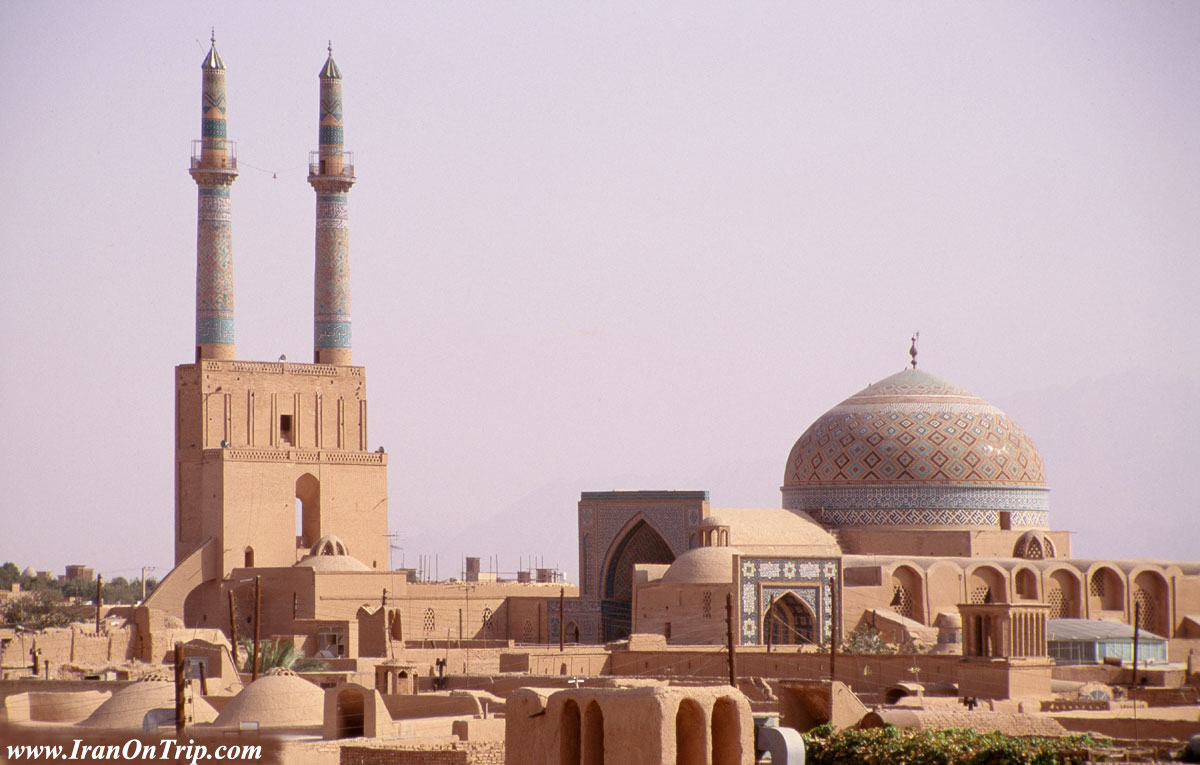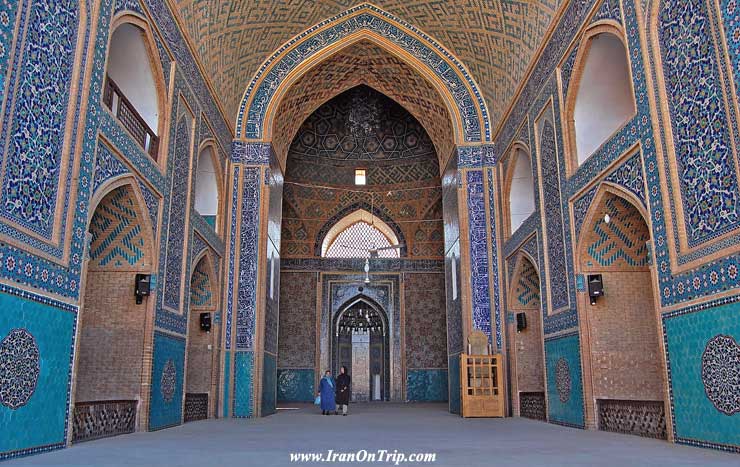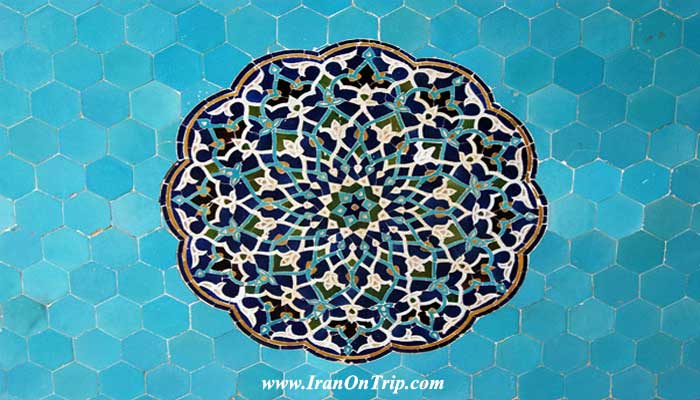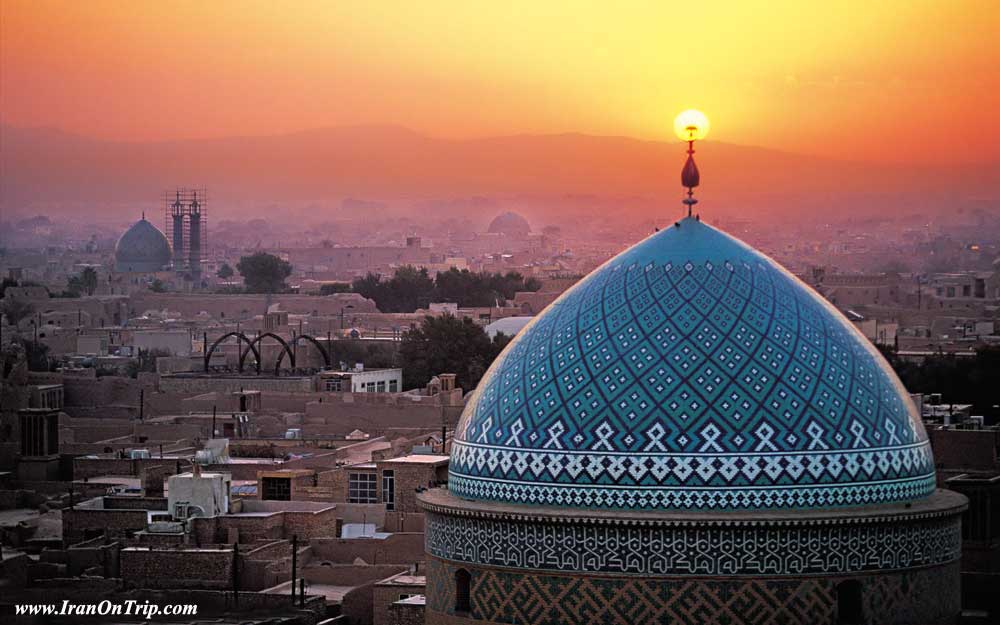Yazd Jame Mosque

The Jameh Mosque of Yazd (Persian: مسجد جامع یزدThe Masjid-e-Jameh Yazd is the grand, congregational mosque (Jameh) of Yazd city, within the Yazd Province of Iran.
The 12th-century mosque is still in use today. It was first built under Ala'oddoleh Garshasb of the Al-e Bouyeh dynasty. The mosque was largely rebuilt between 1324 and 1365, and is one of the outstanding 14th century buildings of Iran.
Specifications

The mosque is a fine specimen of the Azari style of Persian architecture. The mosque is crowned by a pair of minarets, the highest in Iran, and the portal's facade is decorated from top to bottom in dazzling tile work, predominantly blue in colour. Within is a long arcaded courtyard where, behind a deep-set south-east iwan, is a sanctuary chamber (shabestan). This chamber, under a squat tiled dome, is exquisitely decorated with faience mosaic: its tall faience Mihrab, dated 1365, is one of the finest of its kind in existence.
Historic inscriptions

The tile-work bequeathal inscription of the mosque, located in the eastern entrance vestibule, is dated 765 L.H (1364 A.D), the oldest date existing in the building. Other stone and tile-work inscriptions in this vestibule bear the dates 770 L.H (1369 A.D) L.H (1375 A.D) L.H (1417 A.D) L.H (1459 A.D) L.H (1471 A.D) and 974 L.H (1540 A.D) In addition, two edicts by the «Safavid monarch Shah Abbas» dated 1004 L.H (1596 A.D) and 1022 L.H (1613 A.D), one by «Shah Safi» dated 1046 L.H (1636 A.D) , another dated 1047 L.H (1637 A.D), one by «Mirza Mohammad Mohsen» -the governor of Yazd- dated 1115 L.H (1703 A.D) (12) and two other bequeathal inscriptions dated 1121 L.H (1709 A.D) and 1179 L.H (1765 A.D) also exist in this vestibule.
Inscriptions in the eastern portico bear the dates 819 L.H (1416 A.D), 861 L.H (1457 A.D) and 891 L.H (1486 A.D). An

inscription concerning restorations carried out in 1365 L.H (1945 A.D) and another in kufic script dated 1370 L.H (1951 A.D) ,which is a copy of the ancient bequeathal inscription, also appear in this portico. The prayer niche in the gonbadkhaneh bears the date 777 L.H (1375 A.D). An inscription in the main eivan is dated 813 L.H (1410 A.D) and another inscription in this eivan bears the date 836 L.H (1433 A.D) Also, an undated inscription from the time of the «Timurid monarch Shahrokh» exists in the eivan of the mosque. The prayer niche in a small room called qaraatkhaneh and located on the eastern side of the courtyard bears the date 890 L.H (1485 A.D). An inscription recording restorations performed in 1367 L.H (1948 A.D) exists in the northern portico. Also, two tombstones dated 492 L.H (1099 A.D) and 533 L.H (1139 A.D) have retrieved in the ruins of the old part of the mosque, called the «Mosque of Garshasb».
Commissioners and builders
The various parts of this building were erected in the course of time and commissioned by different individuals. Probably the first one has been «Amr Leys Safari». One of the other earliest among these to have commissioned the construction of the masque was «Alaod Dowleh Garshasb ebne Ali ebne Faramarz ebne Alaod Dowleh Abu Jafar Kalanjar» -governor of Yazd between the years 488 L.H (1095 A.D) to 513 L.H (1119 A.D)-. After his dead, while in the same period, the daughters of Faramarz ebne Ali,

from the «Kakui» dynasty, added other parts to the mosque. Today no traces of the ancient parts remain; and the present building was commissioned by «Seyyed Roknod Din Mohammad ebne Qavamod Din Mohammad ebne Nazem Hosseini Yazdi Qazi», died in 732 L.H (1332 A.D), and completed after his death by «Mowlana Saied Sharafod Din Ali». Other parts of the mosque were built by «Amir Shamsod Din Qazi» and «Amir Balaqdar» and later by «Shah Yahya ebne Mozaffar» in 777 L.H (1375 A.D). The minarets of the mosque`s portico were probably built by «Aqa Jamal-od Din Mohammad» known as «Mehtar Jamal» -the minister of Yazd under «Safavid Shah Tahmasb».
The building of the mosque was restored and other parts and decorative elements were added to it in different periods. The contributors to these restorations and additions included: «Zahirod Din Abu Mansour Faramarz» -the first Amir of the Kakui dynasty- in 432 L.H (1041 A.D) , «Alaod Dowleh Amir Ali ebne Faramarz» and his wife -«Arsalan Khatoon»- between years 455 L.H (1063 A.D) to 488 L.H (1095 A.D), «Amir Shamsod Din» -the son of «Amir chaqmaq»- and «Abul Ozra» -a «Gourkani»`s agent- in the decade of 850 L.H (1446 A.D), «Khajeh Jalalod Din Mahmood Kharazmi» in 809 L.H (1406 A.D), «Shah nezam Kermani» -the governor of Yazd under the «Timurid Shahrokh»- in 819 L.H (1416 A.D) , «Bibi Fatemeh Khatun» -the wife of Amir chaqmaq in 830 L.H (1427 A.D) or 836 L.H (1433 A.D) , «Khajeh Moinod Din Maybodi» -a minister of Yazd under the «Timurids» before the year 861 L.H (1457 A.D) , «Amir Nezamod Din Haji Qanbar Jahanshahi» in 862 L.H (1458 A.D) , «Mowlana Abdul Hayy» and «Mowlana Shahabod Din Abdollah» during the «Safavid» period before 1090 L.H (1679 A.D) , «Prince Mohammad Vali Mirza» in 1240 L.H (1825 A.D) , and «Seyyed Ali Mohammad Vaziri» in the year 1324 S.H (1945 A.D).
Various sources
as well as existing inscriptions, name the different architects involved in the construction of this mosque. These artists include: «Mowlana Afifod Din Memar» during the first half of the eight lunar hijri century , «Mowlana Ziaod Din Mohammad Memar» in 777 L.H (1375 A.D) , «Sonollah Memar Yazdi» in 947 L.H (1540 A.D) and «Omar ebne Mahmood Haj Tajod Din» which his name appears in an undated inscription in the eastern portico . The architect of the dome was the architect from Yazd, «Saad ebne Mohammad Kadook», but the inscription of the dome bears no date. The portico and minarets were restored in 1365 L.H (1945 A.D) by the architect from «Mehriz», «Hossein Ali Mahmoodi».
The calligraphers of the mosque`s inscriptions include: «Bahaod Din Hezar Asp» , «Mowlana Shamsod Din Mohammad Shah Hakim Khattat» , «Mowlana Kamalod Din ebne Shahabod Din» known as «Assar» in which two inscriptions dated 863 L.H (1459 A.D) and 875 L.H (1471 A.D) by him are visible in the eastern entrance vestibule and another inscription by the same calligrapher exist in the prayer niche of the gonbadkhaneh which although undated obviously belongs to the same period , «Soltan Mohammad» , «Noorod Din Mohammad Kachui» , «Abu Taleb» , «Zabihi» , and «Ali Mohammad Kaveh» . The inscriptions also give the names of their stone-carvers as «Mohammad Reza», «Soltan Mohammad Yazdi» and his son -«Mohammad Amin»-.
The name of the artist in charge of the superb tile-worked prayer niche of gonbadkhanrh, «Haj Bahaod Din Mohammad ebne Abi Bakr ebne Alhosseini», appears on its inscription dated 777 L.H (1375 A.D). In the vestibule of the eastern entrance, a collection of tessellated tiles dated 820 L.H (1417 A.D) that could also be read as 982 L.H (1574 A.D) bears the name of «Qotbod Din Sayrafi». These tiles were unearthed from under the remains of the Garshasbi garmkhaneh. The panels in the vestibule give the names of the building`s bequeathers as «Ebne Soltan Mahmood Haji Afzal» and «Khajeh Aminod Din ebne Hossein ebne Ali.
Information from written sources
«Donald Wilber» has recorded that remains of an ancient mosque probably belonging to before the «Seljuq period» exist on the eastern side of the courtyard. The ruins of this building were still in existence as late as a few decades ago and «Maxime Siroux» has included several pictures of them in his essay on the Jame Mosque of Yazd.
Evolution of the building
The present-day mosque stands on the site of three mosques that had been built in the course of successive centuries and eventually transformed, in the «Qajar period», into a single edifice with a vast courtyard. The first mosque, i.e. «Atiq Jame Mosque», was built in the second half of the third lunar hijri century, during the reign of Saffarid monarch Amr Leys, following a shabestan design. This mosque was repaired and restored in the second half of the fifth lunar hijri century, under the Kakui rulers of Yazd, and a minaret was erected beside it which remained standing until the ninth lunar hijri century. Remnants of the original mosque subsisted on the northeast of the present mosque`s courtyard until 1324 S.H (1945 A.D).
The second mosque, i.e. the «Qadim (65) ۞ Jame Mosque», was built under Alaod Dowleh Garshasb ebne Ali ebne Faramarz -one of the Kakui rulers of Yazd-. This mosque, the design of which comprised a gonbadkhaneh equipped with an eivan, was built on the western side of the Atiq Mosque; follwing which the daughters of Faramarz ebne Ali Kakui had a shabestan and a mausoleum erected beside it. This mosque existed until 1240 L.H (1825 A.D), when its major part was demolished during the renovation and enlargement of the ensemble.
The third mosque, i.e. the «No Jame Mosque», was built in the first half of the eighth lunar hijri century by «Seyyed Roknod Din Mohammad Qazi» behind the qebleh of the Qadim Jame Mosque. This mosque had a small courtyard and a huge gonbadkhaneh and eivan. Maxime Siroux believes that this building was part of the project of a four-eivan mosque which was not carried out. In 777 L.H (1375 A.D), Shah Yahya ebne Mozaffar`s building activities resulted in extensive decorative tile-work in No Jame Mosque and the construction of its eastern shabestan and massive portico.
In 809 L.H (1406 A.D), during the rule of «Khajeh Jalalod Din Kharazmi», the tile-work decoration of the mosque was continued. At this time, the writing of the «Inna Fatahna» surah around the square courtyard and the mosque`s eivan and gonbadkhaneh was begun, and completed in 819 L.H (1416 A.D), under Shah Nezamod Din Kermani, concurrently with the construction of the western shabestan and portico. Shah Nezamod Din also had the caravansary opposite the mosque`s portico transformed into a forecourt. This forecourt had two central pools, as can be seen in the plan drafted by Maxime Siroux.
In 825 L.H (1422 A.D), during the rule of Amir Chaqmaq, restoration and renovation works were carried out in the Atiq Jame Mosque which continued until 846 L.H (1442 A.D). Maxime Siroux believes that the minarets of the main portico were probably built at this time. Another probability is that these minarets were added to the portico during the reign of Safavid Shah Tahmasb. Inscriptions belonging to this time are visible in the portico.
During the reign of the «Qajar monarch Fath Ali Shah», extensive construction works were carried out in the mosque which resulted in the demolition of many parts of the three congregational mosques. At this time, the present Jame Mosque took shape as a single building. During the enlargment of the No Jame Mosque`s square courtyard and the demolition of three of its sides, part of the Quranic inscription around the courtyard were destroyed and today only parts of it remain on the southern side, the gonbadkhaneh and eivan. Also, major parts of the Atiq and Qadim congregational mosques were demolished and replaced by the No Jame Mosque`s courtyard. The remaining parts on eastern and western sides of the new courtyard were restored. Meanwhile, the northern portico of the mosque was rebuilt on the side of the entrance dating back to the reign of Garshasb. During the reign of «Qajar monarch Nasered Din Shah», the eastern shabestan, the main entrance vestibule, the tall minarets of the portico and the braces of the gonbadkhaneh were restored.
The building of the mosque has sustained heavy damage in recent times, but was restored in 1324 S.H (1945 A.D) upon the initiative of «Haj Seyyes Ali Mohammad Vaziri». At this time, the remains of the Atiq Jame Mosque, which had fallen into ruin besides the mosque`s courtyard, were demolished and replaced by a new shabestan.
.....
.....
.....

.jpg)



























